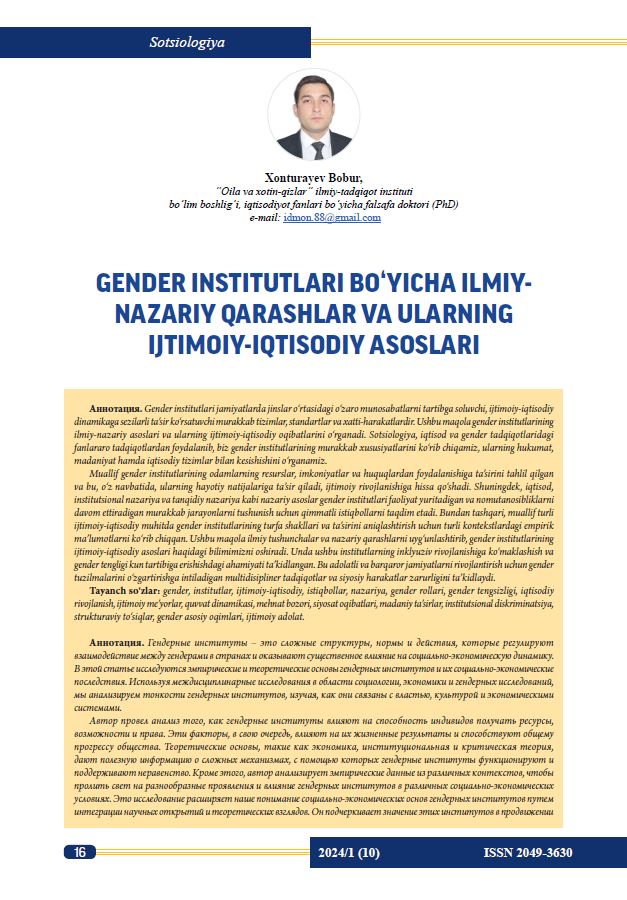Scientific and theoretical views on gender institutions and their socio-economic foundations
DOI:
https://doi.org/10.65185/mojgo.vi.125Abstract
gender institutions are intricate frameworks, norms, and actions that govern the interactions between genders in countries and have a substantial influence on socio-economic dynamics. This article explores the empirical and theoretical underpinnings of gender institutions and their socio-economic ramifications. Utilizing interdisciplinary research from sociology, economics, and gender studies, we analyze the intricacies of gendered institutions, investigating how they connect with power, culture, and economic systems.
The author conducted an analysis of how gender institutions influence individuals’ ability to get resources, opportunities, and rights. These factors, in its turn, have an effect on their life outcomes and contribute to the overall progress of society. Theoretical frameworks such as economics, institutional theory, and critical theory provide useful insights into the intricate mechanisms by which gendered institutions function and sustain disparities. Furthermore, the author analyzes empirical data from various contexts to elucidate the diverse manifestations and impacts of gender institutions in distinct socio-economic settings. This research enhances our understanding of the socio-economic foundations of gender institutions by integrating scientific discoveries and theoretical views. It emphasizes the significance of these institutions in advancing inclusive development and accomplishing the gender equality goal. This emphasizes the need of doing interdisciplinary research and implementing policy measures that aim to reshape gender frameworks, with the goal of fostering equitable and environmentally responsible communities.
Keywords:
gender gender inequality labor marketReferences
Mohr, J., & White, H. (2008). How to model an institution. Theory and Society, 37, 485-512. https://doi.org/10.1007/S11186-008-9066-0.
Meadows, P. (1967). The Rhetoric of Institutional Theory. Sociological Quarterly, 8, 207-207. https://doi.org/10.1111/J.1533-8525.1967.TB01048.X.
Acker, J. (1990). “Hierarchies, Jobs, Bodies: A Theory of Gendered Organizations.” Gender & Society, 4(2), 139-158.
Messner, Michael. 2009. “Boyhood, Organized Sports, and the Construction of Masculinities.” Pp. 119-135 in Reconstructing Gender: A Multicultural Anthology by Estelle Disch. Boston. McGraw-Hill Higher Education.
Epstein, C. (2007). Great Divides: The Cultural, Cognitive, and Social Bases of the Global Subordination of Women. American Sociological Review, 72. pp. 1 – 22 // https://doi.org/10.1177/000312240707200101.
McCarthy, L., & Moon, J. (2018). Disrupting the Gender Institution: Consciousness-Raising in the Cocoa Value Chain. Organization Studies, 39. pp. 1153 – 1177 // https://doi.org/10.1177/0170840618787358.
Kronsell, A. (2006). Feminist Methodologies for International Relations: Methods for studying silences: gender analysis in institutions of hegemonic masculinity., 108-128. https://doi.org/10.1017/CBO9780511617690.008.
Martin, P. (2004). Gender As Social Institution. Social Forces, 82. pp. 1249 – 1273 // https://doi.org/10.1353/sof.2004.0081.
Youngberry, A., & Prangnell, J. (2013). Fences, Boats and Teas: Engendering Patient Lives at Peel Island Lazaret. International Journal of Historical Archaeology, 17. pp. 445-464 // https://doi.org/10.1007/S10761-013-0233-2.
Staveren, I., & bode, O. (2007). Gender Norms as Asymmetric Institutions: A Case Study of Yoruba Women in Nigeria. Journal of Economic Issues, 41. pp. 903-925 // https://doi.org/10.1080/00213624.2007.11507080.
Umumiy o‘rta ta’lim maktablarining 10-sinfi uchun ona tili darsligi. – Toshkent, 2022.
Kenney, S. (1996). New Research on Gendered Political Institutions. Political Research Quarterly, 49, 445 - 466. https://doi.org/10.1177/106591299604900211.
Connell, R. (1985). Theorizing Gender. Sociology, 19, 260 - 272. https://doi.org/10.1177/0038038585019002008.
Hearn, J. (2013). The sociological significance of domestic violence: Tensions, paradoxes, and implications. Current Sociology, 61, 152 - 170. https://doi.org/10.1177/0011392112456503.
Martin, P. (2004). Gender As Social Institution. Social Forces, 82, 1249 - 1273. https://doi.org/10.1353/sof.2004.0081.
Butler, J. (1990). “Gender Trouble: Feminism and the Subversion of Identity.” New York: Routledge.
Crenshaw, K. (1989). “Demarginalizing the Intersection of Race and Sex: A Black Feminist Critique of Antidiscrimination Doctrine, Feminist Theory and Antiracist Politics.” University of Chicago Legal Forum, 1989(1), Article 8.
Beauvoir, S. de. (1949). “The Second Sex.” Paris: Gallimard.
Freud, S. (1924). “The Dissolution of the Oedipus Complex.” In J. Strachey (Ed. and Trans.), The Standard Edition of the Complete Psychological Works of Sigmund Freud, Volume XIX (1923-1925): The Ego and the Id and Other Works (pp. 173-179). London: Hogarth Press.
Mead, M. (1935). “Sex and Temperament in Three Primitive Societies.” New York: William Morrow & Company.
Scott, J. W. (1986). “Gender: A Useful Category of Historical Analysis.” The American Historical Review, 91(5), 1053-1075.
Chang, K. (2018). “Rethinking Gender Institutions: Towards Progressive Transformation.” Gender & Society, 32(4), 563-589.
Smith, J., & Roberts, A. (2020). “The Role of Gender Institutions in Socio-Economic Development: A New Perspective.” Journal of Gender Studies, 29(3), 345-360.
Lee, K. (2021). “Transformative Potential of Gender Institutions: Beyond Reflection to Socio-Economic Change”. International Review of Sociology, 31(2), 204-223.
Goldin, Claudia. (1995). “The U-Shaped Female Labor Force Function in Economic Development and Economic History”. In Schultz, T. Paul (Ed.), “Investment in Women’s Human Capital and Economic Development,” pp. 61-90. University of Chicago Press.
Elson, Diane. (2002). “Macroeconomics and Macroeconomic Policies from a Gender Perspective.” Public Finance and Management, 2(3). pp. 306-322.
Kabeer, Naila & Natali, Luisa. (2013). “Gender Equality and Economic Growth: Is There a Win-Win?” IDS Working Papers, 2013(417), pp. 1-58.
Unterhalter, Elaine. (2005). “Global Inequality, Capabilities, Social Justice: The Millennium Development Goal for Gender Equality in Education.” International Journal of Educational Development, 25(2), pp. 111-122.
Weiss, M. (2017). “The Impact of Gender-Inclusive Educational Policies on Economic Growth”. Journal of Education and Social Policy, 4(2), pp. 1-10.
O‘Connor, P. (2020). Why is it so difficult to reduce gender inequality in male-dominated higher educational organizations? A feminist institutional perspective. Interdisciplinary Science Reviews, 45, pp. 207-228 // https://doi.org/10.1080/03080188.2020.1737903.

Downloads
Published
How to Cite
License
Copyright (c) 2025 Xonturayev Bobur

This work is licensed under a Creative Commons Attribution 4.0 International License.









